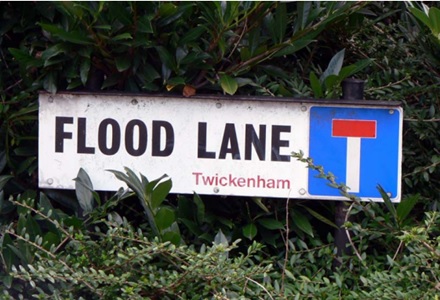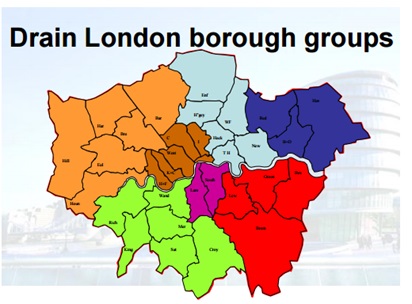Delay in the launch of Drain London interim report

Drainage in London – Delay in the launch of Drain London interim report.
Unda learnt last week that The Drain London Interim Report which was expected to be launched back in April 2015 has been delayed until March 2016. The main focus of Drain London’s project over the last five years has been to develop a long term strategy and action plan to increase the use of sustainable drainage systems in London. The Report will therefore summarise those findings and set out the next phases of work.
The Report will also be accompanied by The London Sustainable Drainage Action Plan, which the London Mayor will publish imminently for consultation – the aim of this document is to increase the delivery of sustainable drainage in London over the next 25 years.
All of this is in response to the Mayors climate change and adaption strategy for London which was issued back in October 2011. The strategy entitled; Managing Risks and Increasing Resilience details the three major challenges facing London as a result of changing climate and weather and how they intent to be managed to help London to adapt and lessen the impact and costs on the capital. These are; flooding, drought and heatwaves. The Drain London programme was created to help reduce flood risk in London.

Textual changes to Policy 5.13 in the London Plan:
Meanwhile, Mayor’s London Plan which was updated back in March 2015 and now entitled The London Plan (consolidated with alterations since 2011) has a strong policy (Policy 5.13) to promote the use of sustainable drainage systems in new developments. The Policy 5.13 Sustainable Drainage has remained substantively the same, although there may be some minor text changes. The Policy states:
POLICY 5.13 SUSTAINABLE DRAINAGE (pg 205)
Planning decisions
- Development should utilise sustainable urban drainage systems (SUDS) unless there are practical reasons for not doing so, and should aim to achieve greenfield run-off rates and ensure that surface water run-off is managed as close to its source as possible in line with the following drainage hierarchy:
- store rainwater for later use
- use infiltration techniques, such as porous surfaces in non-clay areas
- attenuate rainwater in ponds or open water features for gradual release
- attenuate rainwater by storing in tanks or sealed water features for gradual release
- discharge rainwater direct to a watercourse
- discharge rainwater to a surface water sewer/drain
- discharge rainwater to the combined sewer.
Drainage should be designed and implemented in ways that deliver other policy objectives of this Plan, including water use efficiency and quality, biodiversity, amenity and recreation.
LDF preparation:
- Within LDFs boroughs should, in line with the Flood and Water Management Act 2010, utilise Surface Water Management Plans to identify areas where there are particular surface water management issues and develop actions and policy approaches aimed at reducing these risks.
Drain London explained:
The Drain London programme was set up to help predict and manage surface water by improving the knowledge of the surface water drainage system and identifying those areas at most risk of flooding and how to reduce flood risk. It was created in response to the Mayor’s London Regional Flood Risk Appraisal October 2009, which identified surface water flood risk as the most likely cause of flooding in London.
Drain London is leading a partnership of 33 London boroughs, the Environment Agency, Thames Water and Transport for London. We also work with other bodies that have drainage responsibilities in London through the Drain London Forum.

Flood risk modelling through Drain London has helped London’s boroughs to better understand the risk’s in their borough and to produce a Surface Water Management Plan to help manage and reduce those risks. The 33 London Boroughs which are part of the Drain London partnership have each produced Surface Water Management Plan’s for their boroughs. It’s easy to identify which local authority your property is located using the Direct Gov website.
- City of London (not a London borough)
- City of Westminster
- Kensington and Chelsea
- Hammersmith and Fulham
- Wandsworth
- Lambeth
- Southwark
- Tower Hamlets
- Hackney
- Islington
- Camden
- Brent
- Ealing
- Hounslow
- Richmond upon Thames
- Kingston upon Thames
- Merton
- Sutton
- Croydon
- Bromley
- Lewisham
- Greenwich
- Bexley
- Havering
- Barking and Dagenham
- Redbridge
- Newham
- Waltham Forest
- Haringey
- Enfield
- Barnet
- Harrow
- Hillingdon
Drain London is also working on several projects that show how surface water can be managed in a more sustainable way. This includes converting impermeable surfaces into green permeable surfaces, diverting rainwater pipes into landscaped areas and restoring river corridors to absorb more water.
It is often necessary to undertake a Flood Risk Assessment or Surface Water Drainage Strategy when undertaking development in these boroughs. Additionally, people looking to purchase property or invest in these locations should robustly assess flood risk to ensure that they are aware of the implications for insurance, or on their business operations.